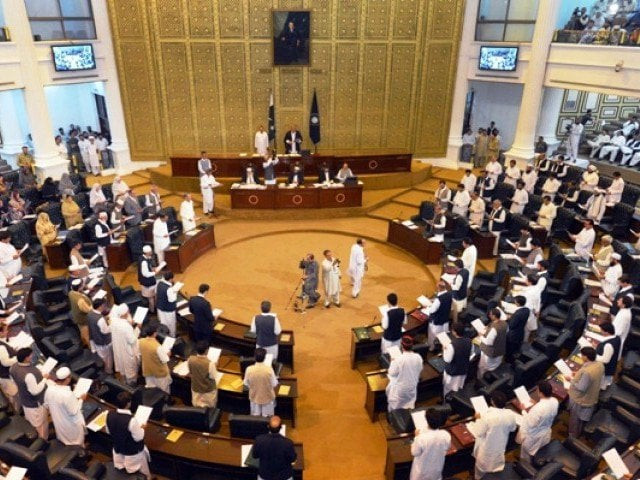Women outperform men in K-P Assembly: report
Female lawmakers contributed more than one-fifth of the assembly’s agenda over the past 44 months

Khyber-Pakhtunkhwa Assembly. PHOTO: AFP
The report discussed in detail the performance of women legislators between June 2013 and February 2017.
It stated that the percentage of women in the provincial assembly was 17 per cent. There were only 22 women lawmakers in the assembly out of 124 legislators.
Terming the performance of women legislators better than their male counterparts, the report stated that each woman lawmakers represented 596,652 women but their male counterparts represented 130,064 men.
The report was issued at a ceremony arranged to pay tribute to women legislators for their remarkable contribution.
Khyber-Pakhtunkhwa Assembly Deputy Speaker Dr Meher Taj Roghani was the guest of honour.
According to the report, the total population of the province was 26,392,939 with 13,266,586 men while women were 13,126,353.
Of the total, registered voters numbered 14,015,689 with 8,006,654 men and 6,009,035 women.
The report lamented that none of the 22 women lawmakers had been directly elected to the assembly. Only one out of 14 ministers was a woman. Seven out of 18 parliamentary secretaries and four of 38 committee chairpersons were women.
Women lawmakers, the report stated, had a higher attendance rate in the assembly sessions than male lawmakers.
According to the official attendance record, women lawmakers attended 167 of 219 (76 per cent) sittings on an average while men attended 133 (64 per cent) sessions. Most of the women lawmakers had more than 70 per cent attendance during the period under review.
Female lawmakers contributed more than one-fifth of the assembly’s agenda over the past 44 months.
They submitted 693 (20 per cent) questions, eight adjournment motions (16 per cent), 47 call-attention notices (17 per cent), demonstrating their interest in the assembly’s core functions, including the executive’s oversight.
They also represented public issues through resolutions. Women legislators sponsored 46 per cent of resolutions brought before the house. They also contributed to the legislation, sponsoring six out of 17 private members’ bills.
The assembly also responded to some of the women issues by enacting relevant legislations or recommending suggestions to the government via resolutions.
Among the achievements of women lawmakers are: regularisation of the Lady Health Workers programme, besides putting in place a law to protect the rights of working women. The assembly also set up an institutional mechanism for providing for women’s welfare in general and widowed women in particular.
Published in The Express Tribune, March 10th, 2017.













COMMENTS
Comments are moderated and generally will be posted if they are on-topic and not abusive.
For more information, please see our Comments FAQ